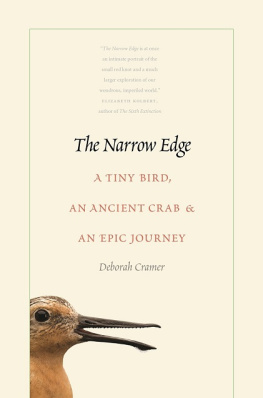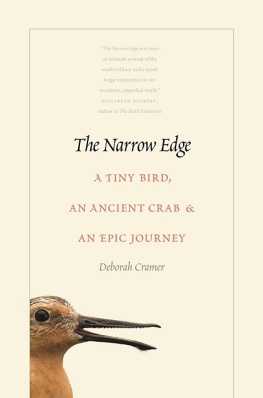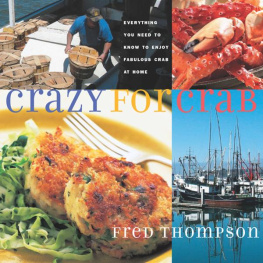CRAB WARS
A Tale of Horseshoe Crabs, Bioterrorism, and Human Health

WILLIAM SARGENT
University Press of New England
HANOVER AND LONDON
UNIVERSITY PRESS OF NEW ENGLAND
One Court Street, Lebanon, NH 03766
www.upne.com
2002 by Francis W. Sargent
Postscript 2006 by Francis W. Sargent
First University Press of New England paperback edition 2006
All rights reserved. No part of this book may be reproduced in any form or by any electronic or mechanical means, including storage and retrieval systems, without permission in writing from the publisher, except by a reviewer, who may quote brief passages in a review. Members of educational institutions and organizations wishing to photocopy any of the work for classroom use, or authors and publishers who would like to obtain permission for any of the material in the work, should contact Permissions, University Press of New England, One Court Street, Lebanon, NH 03766.
ISBN for the paperback edition: 9781584655312
eISBN: 978-1-61168-716-3
LIBRARY OF CONGRESS CATALOGING-IN-PUBLICATION DATA
Sargent, William, 1946
Crab wars : a tale of horseshoe crabs, bioterrorism, and human health / William Sargent.
p. cm.
ISBN 1584651687 (cloth : alk. paper)
1. Limulus polyphemus. 2. Limulus polyphemusResearch. 3. Limulus test. 4. Pharmaceutical industry
Corrupt practices. I. Title.
QL447.7 .s27 2002
Contents
Preface
During World War II, John Steinbeck wrote a book about collecting marine animals with his mentor Ed Ricketts. He spoke of taking a tiny colony of corals from a tidal pool and how it wasnt very important to the pool itself. He wrote of Japanese fishing boats dredging up tons of shrimp and how that wasnt very important to the Pacific Ocean. He wrote of the bombs that were then falling throughout the world and how the stars were not moved thereby. He wrote of how all of it is important or none of it was important at all.
I was reminded of those words as I replayed the image of the twin towers of the World Trade Center tumbling into a smoldering pile of dust. What was I doing writing about horseshoe crabs when thousands of people had just died and the airwaves were full of the inciting rhetoric of a holy war?
But as the days unfolded, I gradually realized I was doing something important. I was writing about an animal that has been on this planet three hundred times longer than our own species. I was honoring an animal that has saved a million more human lives than died in the World Trade Center, or will probably die in the aftermath. I was writing about caring for our precious planet that we think we can bomb with impunity to achieve safety from members of our own speciespeople genetically identical to ourselves. I was trying to show the miracle of the universe, the miracle that all life is related, the miracle that all people on the earth are part of the same contentious family, the reality that we must find a way to live together on our wonderful teeming planet or destroy it for all eternity. In my own way I was praying for that never to happen.
As Steinbeck wrote during the last war that so endangered our planet, either none of it is very important or all of it is. I like to think the latter.
Pleasant Bay
September 14, 2001 | W.S. |
Acknowledgments
Many people have helped me write this book. Most have been mentioned in the body of the text. However, I would also like to thank Karen McCullough, Bill Hall, Jim Berkson, and Tina Berger for technical advice; Jim Fair, Frank Germano, and Hoyt and Deborah Ecker for Massachusetts fisheries information; and Scott Hecker of the Massachusetts Audubon Society for general information and kibitzing. Carl Shuster is the grand old man of horseshoe crab researchers. He helped throughout the process of writing this book. I am eagerly awaiting his book.
Norman Wainwright read through the entire manuscript thoroughly; Judge Zobel and Jim Cooper took the time to read over specific chapters. George Buckley was there at the start of our continued explorations of Pleasant Bay, and Troy Hopkins and his students continue the ongoing tradition.
Phil Pochoda, Phyllis Deutsch, Nick King, Scott Allen, and Glenn Ritt have all helped publish previous articles about horseshoe crabs. Betsy Bang, Jack Levin, and John Valois helped with stories of the early days. Jan Nicholls was particularly helpful with recent happenings.
I hope I have not left anyone out or misspelled your names! Any mistakes are mine alone.
PART I

Early Lessons
Introduction
 IN 1956 A HORSESHOE CRAB sludged up and died, not an uncommon occurrence. But this horseshoe crab happened to die in the laboratory of Dr. Frederik Bang, an uncommon scientist who recognized this death was uncommonly like that of rabbits injected with Gram-negative bacteria. That observation led to an exquisite new test for bacterial contamination.
IN 1956 A HORSESHOE CRAB sludged up and died, not an uncommon occurrence. But this horseshoe crab happened to die in the laboratory of Dr. Frederik Bang, an uncommon scientist who recognized this death was uncommonly like that of rabbits injected with Gram-negative bacteria. That observation led to an exquisite new test for bacterial contamination.
Today, over a million human lives have been saved by the horseshoe crab test, and the processed blood of these animals is worth over $15,000 a quart. It is used to detect infinitesimally small quantities of Gram-negative bacteria, which are as ubiquitous in the natural environment as they are lethal in the human bloodstream. The Food and Drug Administration now requires that every scalpel, drug, syringe, and flu shot be tested with the horseshoe crab derivative called Limulus amoeboecyte lysate, or lysate for short.
Producing lysate has become a multimillion-dollar industry headquartered in Boston, Tokyo, and Chicago. There has been intense competition between some of the worlds major pharmaceutical conglomerates to develop or acquire subsidiary companies able to produce stable lysate. But little attention has been paid to the unique animals that have made it all happen. Today the industry is plagued by overfishing, dwindling stocks, problems with endangered species, and regulatory uncertainty.
I have tried to tell the story of the horseshoe crab industry through the eyes of the scientists, fishermen, and biotech pioneers involved. In doing so I have traveled the length of the East Coast, interviewed hundreds of people, studied research papers and court documents, and worked inside the industry.
The story is an intensely human one. Like any good story it has rogues and scalawags as well as dedicated scientistssometimes all wrapped up in the same skin. In many cases I have tried to recreate conversations from long ago. This has not been easy. Few people thought the conversations very memorable at the time, and nobody was taking notes. I have tried to remedy this situation by interviewing everyone involved and comparing their memories of those past events. But people tend to remember details differently. In some cases the participants in the conversations have died, so I have had to rely on the recollections of their wives or colleagues. While I cannot guarantee that these conversations are accurate in every detail, I believe they faithfully reflect the underlying truth and feel of these past events. Where possible I have supplemented peoples memories with quotes from courtroom documents, newspaper articles, and meeting transcipts.
Some of the information in this book comes from my own lifelong interest in horseshoe crabs. My involvement with them stems from childhood fascination and has run the gamut from studying the crabs natural history to writing about their physiology to collecting them for lysate. Each has given me insight into the horseshoe crab industry and the legal, environmental, and economic pressures it faces today.
Next page









